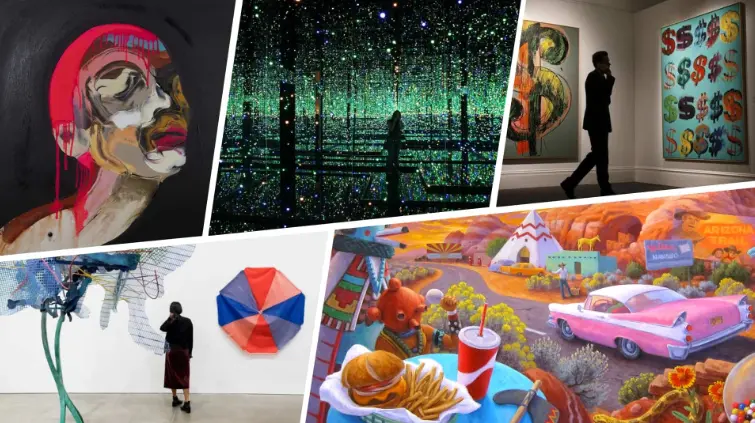Contemporary Art And Its Professionals

What makes art contemporary? What are their characteristics? What artists stand out in this period? What can I work on as an expert in contemporary art ? All the answers to these questions, and many more, are what we are going to address in this article. If your passion is art… do not hesitate to dedicate yourself to it. Keep reading!

Contemporary art is made up of the set of artistic manifestations that emerged from the 20th century. It is true that all art is contemporary for each era: Goya was for those who lived in the 19th century or Leonardo da Vinci for those who lived in the 16th century. However, there are several criteria that are used to determine the moment from which we can call artistic expressions contemporary. Factors that we will discover later.
Andy Warhol, Salvador Dalí, Pablo Picasso, Fernando Botero, Pollock, Matisse… Countless artists who have made this artistic period have a name and surname. Even today we are discovering new faces and new contemporary works of art that are leaving their mark on the history of art. Would you like to become an expert? Let’s go there!
What do we call contemporary art?
As we say, according to the concept as such, the online animator courses are always contemporary for the society of the moment. However, this artistic stage receives this name for a series of reasons. T here are three criteria that are used to determine the moment from which the artistic expressions of our time can be called contemporary:
- Art and contemporary age
One of the broadest criteria links the beginning of contemporary art with the beginning of the Contemporary Age, that is, at the end of the 18th century with the French Revolution (1789-1799). Here, this art begins with Romanticism , which was characterized by emphasizing freedom, individuality, sentimentality and subjectivity.
- Contemporary art and avant-garde
Another criterion judges as contemporary that art that emerged from the avant-garde emergence of the beginning of the 20th century. A series of ideas that revolutionized the institution of art, such as the break with traditional models or its critical and experimental nature. Some contemporary artistic movements at this time would be Dadaism , Cubism , Surrealism and others that we will see later.
- Contemporary art and postmodernism
Finally, a third criterion takes as its starting point the beginning of Postmodernism or the end of the Second World War, in 1945. This contemporary art would be reflected in the second avant-garde wave of the century , made up of movements such as pop art , minimalism , abstract expressionism or urban art .
Characteristics
- It is based on abstract expressionism
- Look for different forms of expression
- It has bases from abstract art
- His works are original and artistic
- The means or instruments to create works of contemporary art are changing and new technologies are used.
- Gives emphasis to expressions of self and emotions
- The colors used are strong and the content is symbolic
- Seeks to manifest the movement and repetition of objects on the canvases
- The art is avant-garde and surreal.
How to Master in Contemporary Art?
Immerse yourself in diverse art forms, from paintings to installations, understanding the evolution of contemporary art.
Engage with contemporary artists and their works, attending exhibitions, galleries, and art events to broaden your perspective.
Analyze critical theories, cultural contexts, and societal influences shaping contemporary art, developing a nuanced understanding of its significance and trends.
Contemporary art movements
- Fauvism. It emerged as a reaction to Impressionism . Its main appearance was the color, the flat and extensive spots.
- Cubism. Its creators were Picasso and Braques. They used neutral tones to create a fourth dimension and used transparencies.
- Expressionism. It is a means to express the anguish that the individual suffered through paintings full of drama, expressive and caricature of the figures.
- Dadaism. It arose as a protest against the First World War. It was a kind of mockery of technology and progress.
- Surrealism. Painters used resources such as animation of the inanimate world, isolation of anatomy, fantastic machines that evoked chaos.
- Abstract art . It is known as kinetic art or pop art. His idea is based on the fact that any type of geometric shape that was drawn could lose stability in the retina of the person who was observing it through the optical illusion.
Contemporary art in all its versions
As a good expert in art , you must understand and know each of its aspects: architecture, sculpture and painting. Well, only then will you be able to advise, direct, invest or appraise works of art. Let’s see!
Architecture
The main idea of this type of architecture is to reject the historical styles that were used in ancient times, including their materials. Iron, zinc and glass began to be used as construction materials. The most important buildings were the columns , temples , triumphal arches and the propylaea , where engineering played an important role.
Sculpture
Here, the sculptures also included new materials and new functions and symbologies were used . Its trends are constantly evolving and the human figure has lost importance with contemporary art.
Paint
Its bases are a set of signs and symbols initiated by modern painters. T he best modern painter was Vincent Van Gogh, whose paintings gave rise to abstract painting and Fauvism.


